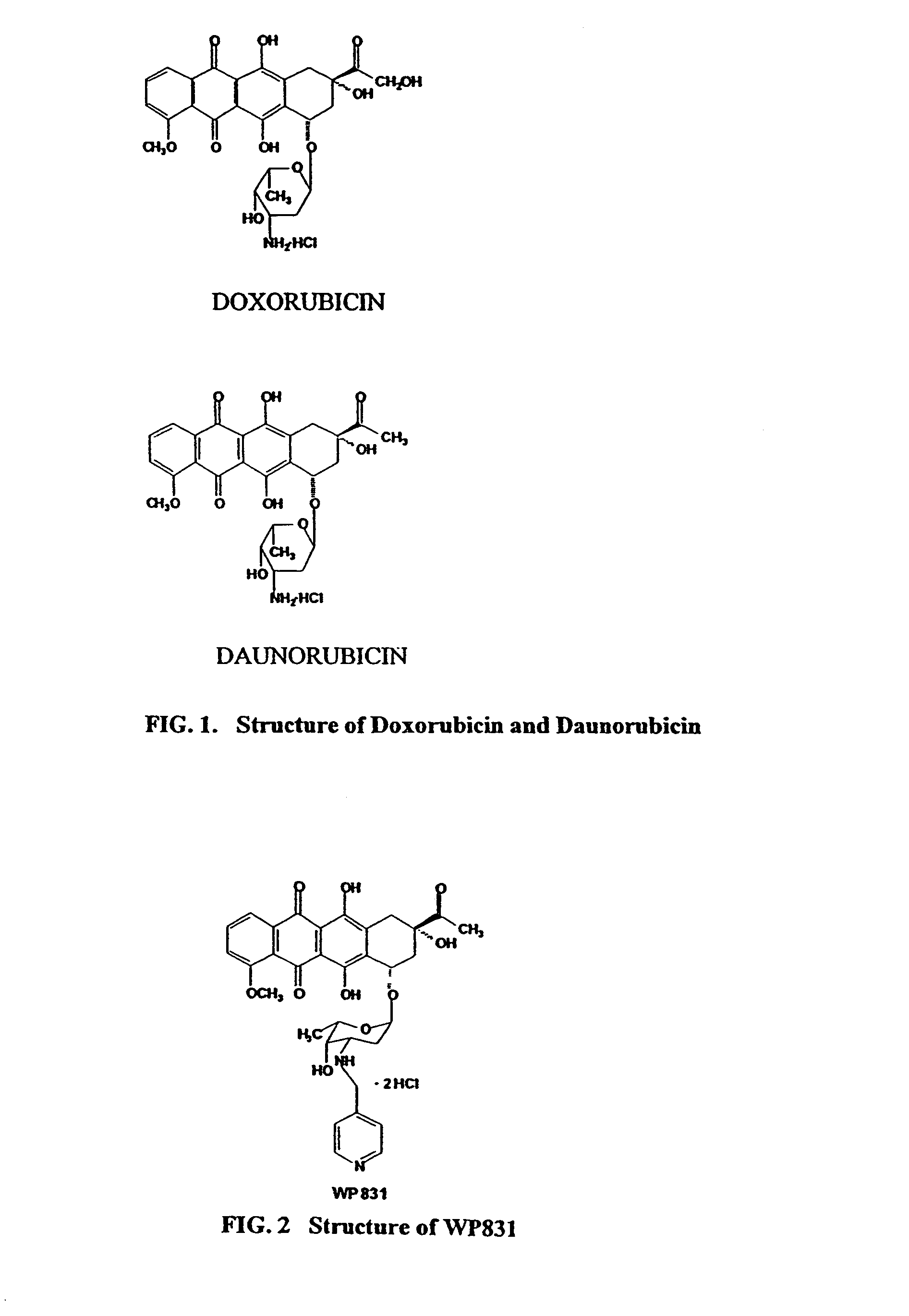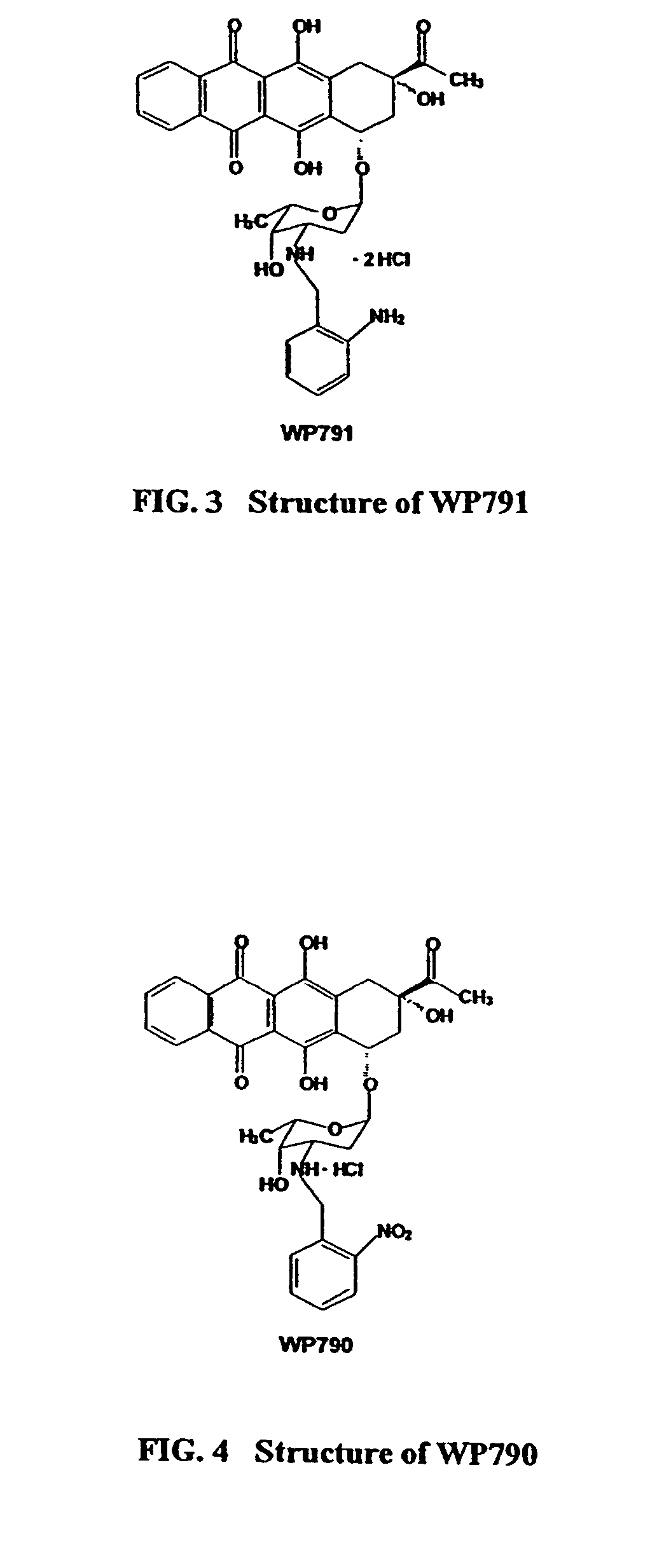Methods and compositions for the manufacture of C-3' and C-4' anthracycline antibiotics
a technology of anthracycline and composition, applied in the field of cancer treatment, can solve problems such as cytotoxic effects, and achieve the effects of reducing cardiotoxicity, preventing and/or overcoming multi-drug resistance, and increasing cytotoxicity
- Summary
- Abstract
- Description
- Claims
- Application Information
AI Technical Summary
Benefits of technology
Problems solved by technology
Method used
Image
Examples
example 1
Synthesis of Exemplary Substituted Anthracyclines having C-3′ Alkylated Anthracyclines Modified at Benzyl Ring
General Procedure for Making C-3′ Alkylated Anthracyclines Modified at Benzyl Ring
A. Synthesis of 3′-N-nonitro benzyl derivatives of daunorubicin and 4-demethoxy-daunorubicin:
[0139]1. Procedure A
[0140]Daunorubicin (1 mmol), 4-nitrobenzyl bromide (1 mmol), and sodium carbonate (250 g) were dissolved in DMF (10 ml). Dichloromethane (10 ml) was added to this solution, and obtained mixture was stirred at room temperature until all substrate was converted into the product. (monitored by TLC). After reaction was completed the reaction mixture was diluted with dichloromethane (100 ml), and washed with water until neutral. The organic solution was dried over sodium sulfate, then drying agent was removed and solvent evaporated under diminished pressure, and product was purified by column chromatography (Silica Gel 60 Merck), using chloroform, chloroform / methanol 98:2, 95:5 as an elue...
example 2
Synthesis of Exemplary C-4′-Alkyl-Aromatic Ring Anthracyclines
General Procedures for Making Anthracycline Analogs with C-4′-Substituted Sugars.
A. Synthesis of 4′-O-benzylated anthracyclines
[0194]1. Procedure A: Coupling and Deacetylation.
[0195]In the one flask a mixture of aglycon (1 mmol), HgBr2 (0.7 g), HgO (2.8 g) and molecular sieves 4 A°(1 g) in dichloromethane (50 ml) was prepared and stirred at room temperature. At the same time, in the second flask, a trimethylsilyl bromide (3 mmol) was added to the solution of 1-O-silylated 3-azido-sugar (2 mmol) in dichloromethane (8 mL). Such reaction mixture was stirred at RT and its progress was monitored by TLC. (Toluene / acetone=8:1). After disappearance of starting sugar, solvent was removed under diminished pressure. Then hexanes (10 mL) were added to the residue and the mixture was evaporated. Such addition and removal of hexanes were repeated three times. Subsequently, the resulting dry residue was dissolved in the dichloromethane ...
example 3
Novel Method for the Synthesis of 4-O-Benzylated Sugars
[0261]Described herein is a method for the preparation of the 4-O-benzylated sugars, used as precursors in the synthesis of 4-O-benzylated-3-hydroxy-anthracyclines like WP727, WP571, WP794, or WP793. This is a novel method superior to other methods described earlier. A direct selective alkylation of acetylated glycals is used which gives almost exclusively products alkylated at C-4. The inventors approach is different from other known methods in the following ways: (1) a one step approach wherein a fully blocked compound is alkylated allowing for an easier and simpler synthesis versus the standard method of alkylating free hydroxyl groups, (2) because the process is selective the major products are 4-O-alkylated compounds. In this method, the first step of the reaction is a selective deblocking (deacylation) of the hydroxyl at C-4 followed by a rapid alkylation of this free hydroxyl group. In contrast, alkylation of unblocked (h...
PUM
| Property | Measurement | Unit |
|---|---|---|
| time | aaaaa | aaaaa |
| delay time | aaaaa | aaaaa |
| delay time | aaaaa | aaaaa |
Abstract
Description
Claims
Application Information
 Login to View More
Login to View More - R&D
- Intellectual Property
- Life Sciences
- Materials
- Tech Scout
- Unparalleled Data Quality
- Higher Quality Content
- 60% Fewer Hallucinations
Browse by: Latest US Patents, China's latest patents, Technical Efficacy Thesaurus, Application Domain, Technology Topic, Popular Technical Reports.
© 2025 PatSnap. All rights reserved.Legal|Privacy policy|Modern Slavery Act Transparency Statement|Sitemap|About US| Contact US: help@patsnap.com



